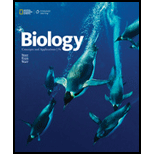
Concept explainers
Introduction:
The nutrients which are required in large amount are known as macronutrients whereas substances which are required in trace amount are known as micronutrients. A plant needs around sixteen nutrients for growth and development.
Answer to Problem 1SQ
Correct answer:
Carbon, hydrogen, and oxygen are the macronutrients and required elements for the plant. Hence, the correct answer is option f.
Explanation of Solution
Reason for correct answer:
Optionf. is given as, “both a and d.”
Carbon, hydrogen, and oxygen are present in abundance in the atmosphere. Carbon is obtained from carbon dioxide, whereas hydrogen is obtained from water by the plants. These nutrients are important for plant’s growth and are required in bulk amount for survival. These elements along with other macronutrients form above 0.5% of plant’s dry weight.
Reason for incorrect answer:
Option a. is given as, “macronutrients.”
Apart from carbon, oxygen, and hydrogen, other macronutrients such as nitrogen, phosphorus, and sulfur are also necessary for plant’s growth and survival. Hence, option a. is incorrect.
Option b. is given as, “micronutrients.”
Chlorine, iron, boron, manganese and many other elements are required by the plant in trace amount and are called micronutrients. Carbon, oxygen, and hydrogen are required in large quantity by the plant and are called macronutrients. Hence, option b. is incorrect.
Option c. is given as, “trace elements.”
Micronutrients such as boron, manganese, and others are also known as trace elements. Carbon, hydrogen, and oxygen are not micronutrients and cannot be called as trace elements. Hence, option c. is incorrect.
Option d. is given as, “required elements.”
Various elements are required by the plants in bulk or trace quantities. The required elements are not restricted to carbon, oxygen, and hydrogen. Other elements such as nitrogen, boron, manganese, and many more are also required by the plant for growth and development. Hence, option d. is incorrect.
Optione. is given as, “both a and b.”
Carbon, hydrogen, and oxygen are required in bulk amount. These elements are called macronutrients. Elements required in low amounts are micronutrients. Carbon, hydrogen, and oxygen cannot be micronutrients. Hence, option e. is incorrect
Hence, the options a, b, c, d, and e are incorrect
Therefore, the given option “both a and d” is correct. Thus, the correct option is f.
Want to see more full solutions like this?
Chapter 26 Solutions
Biology: Concepts and Applications (MindTap Course List)
- Skryf n kortkuns van die Egyptians pyramids vertel ñ story. Maximum 500 woordearrow_forward1.)What cross will result in half homozygous dominant offspring and half heterozygous offspring? 2.) What cross will result in all heterozygous offspring?arrow_forward1.Steroids like testosterone and estrogen are nonpolar and large (~18 carbons). Steroids diffuse through membranes without transporters. Compare and contrast the remaining substances and circle the three substances that can diffuse through a membrane the fastest, without a transporter. Put a square around the other substance that can also diffuse through a membrane (1000x slower but also without a transporter). Molecule Steroid H+ CO₂ Glucose (C6H12O6) H₂O Na+ N₂ Size (Small/Big) Big Nonpolar/Polar/ Nonpolar lonizedarrow_forward
- what are the answer from the bookarrow_forwardwhat is lung cancer why plants removes liquid water intead water vapoursarrow_forward*Example 2: Tracing the path of an autosomal dominant trait Trait: Neurofibromatosis Forms of the trait: The dominant form is neurofibromatosis, caused by the production of an abnormal form of the protein neurofibromin. Affected individuals show spots of abnormal skin pigmentation and non-cancerous tumors that can interfere with the nervous system and cause blindness. Some tumors can convert to a cancerous form. i The recessive form is a normal protein - in other words, no neurofibromatosis.moovi A typical pedigree for a family that carries neurofibromatosis is shown below. Note that carriers are not indicated with half-colored shapes in this chart. Use the letter "N" to indicate the dominant neurofibromatosis allele, and the letter "n" for the normal allele. Nn nn nn 2 nn Nn A 3 N-arrow_forward
- I want to be a super nutrition guy what u guys like recommend mearrow_forwardPlease finish the chart at the bottom. Some of the answers have been filled in.arrow_forward9. Aerobic respiration of one lipid molecule. The lipid is composed of one glycerol molecule connected to two fatty acid tails. One fatty acid is 12 carbons long and the other fatty acid is 18 carbons long in the figure below. Use the information below to determine how much ATP will be produced from the glycerol part of the lipid. Then, in part B, determine how much ATP is produced from the 2 fatty acids of the lipid. Finally put the NADH and ATP yields together from the glycerol and fatty acids (part A and B) to determine your total number of ATP produced per lipid. Assume no other carbon source is available. 18 carbons fatty acids 12 carbons 9 glycerol A. Glycerol is broken down to glyceraldehyde 3-phosphate, a glycolysis intermediate via the following pathway shown in the figure below. Notice this process costs one ATP but generates one FADH2. Continue generating ATP with glyceraldehyde-3-phosphate using the standard pathway and aerobic respiration. glycerol glycerol-3- phosphate…arrow_forward
 Biology: The Unity and Diversity of Life (MindTap...BiologyISBN:9781305073951Author:Cecie Starr, Ralph Taggart, Christine Evers, Lisa StarrPublisher:Cengage Learning
Biology: The Unity and Diversity of Life (MindTap...BiologyISBN:9781305073951Author:Cecie Starr, Ralph Taggart, Christine Evers, Lisa StarrPublisher:Cengage Learning Concepts of BiologyBiologyISBN:9781938168116Author:Samantha Fowler, Rebecca Roush, James WisePublisher:OpenStax CollegeEssentials of Pharmacology for Health ProfessionsNursingISBN:9781305441620Author:WOODROWPublisher:Cengage
Concepts of BiologyBiologyISBN:9781938168116Author:Samantha Fowler, Rebecca Roush, James WisePublisher:OpenStax CollegeEssentials of Pharmacology for Health ProfessionsNursingISBN:9781305441620Author:WOODROWPublisher:Cengage





